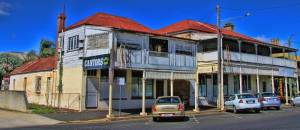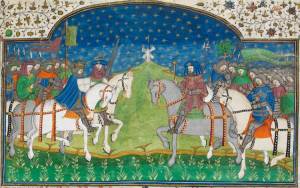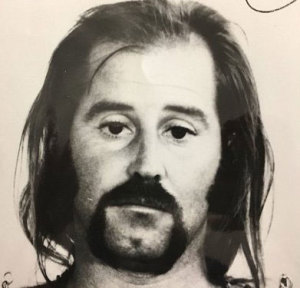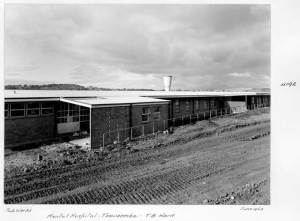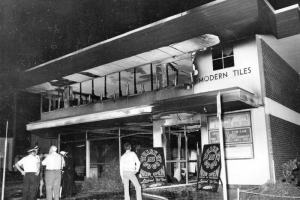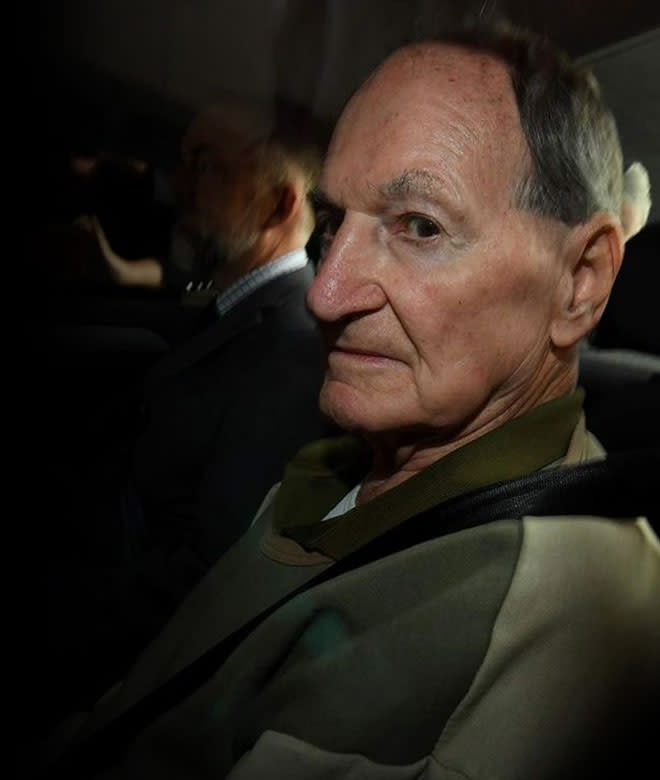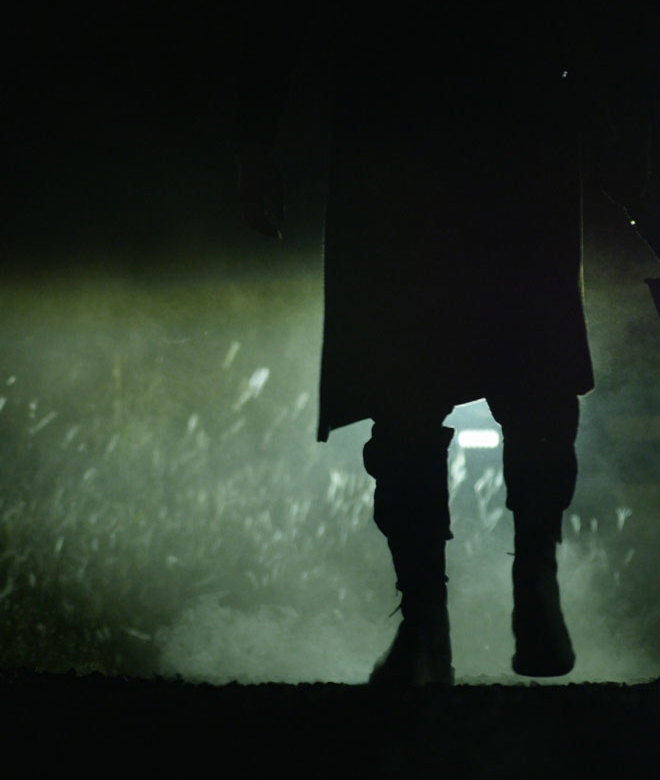Whooshkaa Studios: Listeners are advised this podcast contains coarse language and adult themes, and is not suitable for younger ears. Whooshkaa Studios
on location at Ghost Gate Road. Sound of the car indicator ticking and GPS. MATTHEW CONDON: This is the story of a man you’ve probably never heard of.
His name is Vince O’Dempsey - psychopath, gangster, convicted murderer, and a man who after more than half a century is only now coming into focus as Australia’s worst serial killer.
And this was his playground - Ghost Gate Road – a reputedly haunted tract of bushland outside the little township of Warwick in South-east Queensland. You can find it on a map and visit it anytime, if you dare.
It’s a real place, but it’s also a state of mind if you let it get to you.
CAR GPS Female Voice: “Arrive at Ghost Gate Road. Arrived” This was Vince’s home, his landscape. He knew every inch of this territory from childhood, and as an adult, he put fear in the soil.
In many ways I wish I’d never heard of him.
Because when you go down the trail of investigating Vince, as I have done for many years, he unknowingly slips quietly into the shadowy recesses of your mind, like a fluke or a virus, and embeds himself there.
In this podcast, we will take you inside the head of a living, breathing psychopath. We will reveal the journey of a sadistic killer, already convicted of the brutal murders of a young mother, Barbara McCulkin, and her two young daughters in the 1970s, a man who has self-confessed to thirty-three murders, but whose criminal associates say may be in excess of 100 people.
We will explore puzzles and questions that have hovered around Vince for decades.
Crucially, you will come with us on the search of that most gruesome of Holy Grails - the so-called private graveyard, somewhere near Ghost Gate Road, where Vince allegedly buried his victims, including the McCulkin girls.
On location at Ghost Gate Road
MATTHEW CONDON: “Well, here it is, the entrance to Ghost Gate Road… It’s an incredibly eerie country out here. I can’t help but think that O’Dempsey would have known these fantastical ghost stories as a boy. I mean this was his country. He had explored every square inch of this place… the trees, the water holes the caves, some used by bushrangers in another era, this place, this bush, this grey, frightening bush, it hid him, taught him how to survive and it held onto his secrets it’s no doubt…it just occurred to me here, at the gate, the ghost gate, that maybe I’m walking through… O’Dempsey’s mind. He emerged from this, this landscaped as one friend put it, as a bright shining monster”
I had been warned of the pathogen that is Vince.
Don’t get involved, I was told. Do not look into his story. It will take hold of you, and you won’t be able escape it. He is that dark shadow that lingers at the back of everybody’s mind. Don’t awaken the shadow. Stay away from him.
I didn’t listen.
The deeper I got into my investigation into Vince, the more I learned about my own family’s distant connections to this story, the collateral damage this man wreaked, with people who had been affected by him taking their own lives, and even a warning from one of Vince’s former colleagues that this murderer had taken note of stories I had published about him over the years, and declared me an enemy.
I was hated by a serial killer.
But I couldn’t stop.
Ghost Gate Road Theme Music From Whooshkaa Studios, I’m Matthew Condon, and this is Ghost Gate Road, a podcast that will take you inside the mind of one of the most sadistic killers Australia has ever produced.
News and Archival footage with people close to O’Dempsey’s crimes, with tense music throughout.
LYNNE CUTMORE: “He always buried his victims standing upright.”
MALE NEWS READER: “It’s Mathew Condon’s work that has reopened these cold cases and the skeletons in Brisbane’s cupboards are connected…”
DETECTIVE SERGEANT VIRGINIA GRAY: “Barbra, Vicki and Leanne left the house that night, um, in the company of O’Dempsey and Dubois and they’re never been seen again.”
MALE WITNESS: “Vnce roughly grabbed her, hustled her into the nearby bushes and shrubs and clearly raped her.”
MALE WITNESS: “The thing I remember the most about that is the 15 bodies laid out in white sheets….never left me.”
LYNNE CUTMORE: “Nobody’s going to say anything because you know, you could end up like the rest of them”
POLICE SPOKESPERSON: “Justice is eternal, and so too are the rights of victims…”
MATTHEW CONDON: Every city and town in the world has its ghost stories.
And Warwick - a rural agricultural community 130kms south-west of the capital city of Brisbane in the state of Queensland - was no exception.
The difference with Warwick, though, was that its ghost was a living person. Someone everybody feared. And the horrifying stories that surrounded him just grew and grew over the years, then the decades, until he haunted successive generations of people who lived in that town.
The ghost that walked in Warwick was local Vince O’Dempsey, and his terrifying persona was so embedded in the fabric of the town that just the idea of him was used by parents to subdue their naughty children. If you play up, they would say, Vince will come and get you.
Vince was Warwick’s very own bogeyman.
And for much of his so-called career - from local thug to a ruthless killer and the most feared gangster in the Australian underworld - he remained just that. A spectre. A phantom.
When I first started investigating Vince more than a decade ago, he was still something of a fringe-dweller. He left no paper trail. There were few photographs of him in circulation, despite a life of crime. He lived in the shadows.
How could a man, rumoured to have been involved in possibly dozens of murders, stay off the grid?
That all changed in 2014, on the 40th anniversary of the disappearance of three people - suburban mother Barbara McCulkin, 32, and her two daughters, Vicki, 13, and Leanne, 11.
They were last seen on the evening of Wednesday, January 16, 1974, at their modest rented home at 6 Dorchester Street in South Brisbane.
That night, witnesses saw two visitors at the house. Vince O’Dempsey, and his little mate, Garry “Shorty” Dubois. Both Vince and Shorty had extensive criminal records at that point, and we will explore that soon.
But this was a crime that never healed over time.
What happened to Barbara and the girls? Where were their bodies? Who would kill not just this vivacious young mother, but her two innocent daughters? And why?
Then in 2014, Brisbane cold case homicide squad detective Mick Dowie, and his partner, Detective Virginia Gray, resurrected the triple murder investigation.
Press Conference
DETECTIVE INSPECTOR MICK DOWIE: The thing that goes to the heart of this is the children. It is one thing to murder an adult, it’s another thing to murder two innocent children who could not be in anyway considered a threat to any criminal organisation It is a major step to take to go and murder two innocent children and someone, anyone who has got information that could solve that would have to have had that weighing on their conscience for forty years. If they’ve been justifying it because they think they’re protecting their criminal associates out of some belief that Barbara was going to provide information about their gang, I don’t believe they can justify that anymore, and I don’t believe they could ever justify that in relation to the deaths of the the two girls.
It worked.
By October, Vince and his accomplice,“Shorty”, were arrested for the brutal rape and murder of the McCulkins all those years ago. The news made headlines around the world.
We will explore the full horror of the McCulkin murders later in this podcast, but what was extraordinary about this development was that it had, for the first time, brought Vince out of the shadows and into the light.
It was like those occasional stories in the news of fishermen who sometimes snag terrifying deep sea creatures that nobody has ever seen before. Monsters drawn up from the watery depths.
At his committal hearing the following year, Vince arrived in court in Brisbane dressed in long pants and a knee-length black leather jacket. His oily hair was slicked back. His eyes were pitch black.
Watching him in the dock, a shudder went up my spine. He was every cliche of the heartless killer. He looked dangerous, cold and emotionless, and he scoured the court with those lifeless eyes as a predator might.
And I sat just a few metres from Vince during his trial for murdering the McCulkins. His total indifference to evidence that he bound the McCulkin girls, took them into dark bushland, then raped and murdered them in cold blood, sent chills through the courtroom.
The way the children died - and how he might have disposed of their bodies - still haunts Vince’s criminal associates who were told the story not long after it happened.
How did Vince, born into innocence, as we all are, turn into a killer?
I spent many months driving around Vince’s hometown of Warwick, trying to make sense of this killer, and years talking to people who knew him throughout his life, who went to school with him and boxed with him in amateur rings and were tackled by him in games of rugby league. I tracked down places where he lived and worked, wandered through hotel bars that he once haunted, and stood at the exact places where he had committed some hideous crimes.
But would I ever get to really know him? To penetrate the mind of a multiple murderer?
He was more complex than I ever imagined.
He adored ancient stories and mythology and relished the fighting spirit of the O’Dempsey clan out of Ireland. In the mid-1850s, his great-grandparents, James and Johannah O’Dempsey, washed up at the end of the earth in Warwick, amongst the ancient spurs and folds of the Great Dividing Range, and started a family that would ultimately produce a murderer.
I would soon learn that with this family, and Vince in particular, it is hard to know where the myths end and reality begins.
But one truth is inescapable. Vince is a psychopath.
He was clinically diagnosed as such back in 1955 when he was a troublesome teenager, terrorizing Warwick.
We know this because in 1980 there was a coronial inquest into the presumed murder of the McCulkin girls - Barbara, Vicki and Leanne – held six years after they disappeared off the face of the earth.
Vince was the number one suspect in those murders, and during the inquest he was handcuffed to the bar table during court proceedings in Brisbane.
The doctor who diagnosed the teenage Vince was called to give evidence.
That doctor was Peter Browne Rowland, and between April 1955 and September 1956, he worked as a medical officer at the Toowoomba Mental Hospital in Toowoomba, about 85kms north of the township of Warwick.
During that time, 16-year-old Vince was brought to the hospital and admitted. He was placed in Ward F.
A valuable source during my investigation into Vince gave me the full transcript of the 1980 inquest. Dr Rowland, from the witness stand, explained the reason for Vince’s admission:
A busy courtroom
DR PETER BROWNE ROWLAND (voiced by an actor): … he was put in by his father because of recurrent delinquency in Warwick.
MATTHEW CONDON: Vince had by this time left his Christian Brothers high school in Warwick in grade 9 when he was 14. And he had clearly shown enough troubling behavior to be taken to the Toowoomba Hospital. He remained a patient there for five months.
At the inquest, Dr Rowland was quizzed by legal counsel Garry Forno about Vince’s mental state as a teenager.
A busy courtroom
GARRY FORNO QC (voiced by an actor):… doctor, I want to ask you about your conclusion in relation to Vincent O’Dempsey’s then current condition.
DR PETER BROWNE ROWLAND (voiced by an actor): My conclusion was that he was a psychopathic personality with schizoid tendencies.
GARRY FORNO QC (voiced by an actor): When you refer to schizoid features, could you just, for us, as laymen, in medical terms, perhaps expand on that a little more fully?
DR PETER BROWNE ROWLAND (voiced by an actor): Well the patient, and here I must say I’m referring only to the notes because my memory after such a length of time is far from accurate…but according to the notes in my own handwriting, Mr O’Dempsey, who at the time was sixteen, had very,was devoid of mood changes, normal mood changes. He was withdrawn and apathetic and not responding in the normal way to, with changes of mood and that is a schizoid personality trait…a person with a psychopathic personality has no concept of right or wrong, has no conscience in the normal sense of the word, and is likely to provoke anti-social situations for little or no reason.
MATTHEW CONDON: Dr Rowland was asked if a person with such a personality trait might commit motiveless violent crime:
DR PETER BROWNE ROWLAND (voiced by an actor): yes ,I may say that people with that personality defect often commit violent crimes, yes.
MATTHEW CONDON: The doctor said there was no cure for such an affliction and gave further details of Vince’s incarceration in the mental hospital which, in 1955, was overcrowded with its rows of iron beds, inadequate toilet facilities and outside bath house.
The hospital was bursting at the seams with more than 1,400 patients. Back then, it had only one registered psychiatrist.
A government report into the hospital’s conditions at the time noted that it was home to “acute inebriates, criminals, mental defectives and chronic mental patients”, it was poorly maintained and was so overcrowded that one female ward contained 10 quote “juvenile mental defective boys”.
Dr Rowland originally viewed Vince as a schizophrenic, but over time he concluded otherwise that Mr O’Dempsey was a psychopath.
Vince was discharged from the hospital in late October 1955. He had just turned 17.
DR PETER BROWNE ROWLAND (voiced by an actor): He was released to the care of his father because his father felt, for two reasons, one, his father wanted to give him another chance at home and secondly, because we felt there was no reason for keeping him there. He was under no treatment… no form of treatment. So young Vince went back home to his parents and siblings in Stewart Avenue, Warwick, in the shadow of St Mary’s Catholic Cathedral.
Vince was one of nine O’Dempsey children, many of them intelligent and high-achievers. Although a younger brother would follow his evil trajectory. You’ll learn more about that as we go.
As for Vince, the diagnosed psychopath, he never went back to school after his stay in the mental hospital and returned immediately to his antisocial behavior.
In the course of investigating Vince, I would speak to detectives who had trawled through Vince’s early years and produced evidence that as a youth he enjoyed rounding up stray cats and stabbing them through a hessian bag. He would then disembowel them. These atrocities never made it into the public record.
However, in late 1956, having just turned 18, he was charged with and convicted of stealing. And so began a criminal record that would roll out for decades.
Before we get into that, let’s briefly go back in time to Vince’s early childhood, and paint a picture of his home life.
Sometime during the Second World War the O’Dempsey’s - father Tom and mother Mary - and their nine children, moved from the family farm just outside Warwick to a house in the heart of town.
Tom was a respected real estate and stock agent, and dabbled in side projects like growing vegetables for sale and opening a fish and chip shop. Mother Mary, from one of Warwick’s oldest families, had her hands full with raising so many children. Vince had four brothers and four sisters.
They lived in an old Queenslander-style home, wooden with a corrugated iron roof, which sat on a generous block in Stewart Avenue, behind a car dealership and within sight of St Mary’s Catholic Cathedral.
Parallel to Stewart Avenue was a grid of streets - Palmerin Street, Guy Street, Wantley Street and Dragon Street.
In my research, I discovered the story behind these unusual street names.
They stemmed from the great Medieval myth of Guy of Warwick, the town’s namesake in the UK. Guy, a Palmerin knight, had fallen in love with the Earl of Warwick’s daughter, and to prove his worth, he travelled to Europe, killing dukes and princes and women and children and monsters, as well as a dragon called Wantley.
Palemerin, Guy, Wantley, Dragon. In this ancient tale, Guy, so ashamed of his violent past, becomes a hermit and devotes himself to his Christian faith. Vince lived inside this myth as a boy, became obsessed with it, and later would get a full torso tattoo, front and back, of Guy slaying the dragon.
Perhaps the O’Dempseys moved from the family farm into town to be closer to God.
And perhaps there was good reason to.
According to police investigations, O’Dempsey’s mother Mary noticed there was something decidedly “different” about her son as early as when he was four.
I desperately wanted to see the house where young Vince grew up. Childhood homes tell a story. I wanted to try and imagine Vince inside having dinner in the evening, or bursting out the front door in the mornings, swinging his school bag. Or all dressed up and heading to Mass at St Mary’s.
Vince’s parents were devoted catholics, even today, they are mentioned in the “Pray For” box of names in the St Mary’s parish newsletter, decades after their deaths.
Mary always clutched a set of rosary beads. Vince’s mother was so devoted to the church that she was part of a long-running group called Perpetual Adoration, essentially it involved parishioners sitting and praying inside the church in three 8hour shifts, 24hours a day, effectively guarding the place of worship.
Kerry McGrath went to Mass at St Mary’s as a young man.
KERRY MCGRATH: There used to be the little red light on the sacristy and they had a roster drawn up and someone was in the church saying their rosary or some other prays for 24 hours a day. They were part of the roster. I know, well I don’t know but I was told that the O’Dempsey’s did some of the night shifts…Mrs O’Dempsey. You could never say enough good things about Mary and Tom O’Dempsey. But where did that dormant, evil seed finally germinate in Vince? Did it flourish in Stewart Avenue, sustained by stories of knights and dragons and mass murder?
It was where a teenage Vince was living when he was diagnosed as a psychopath.
When I finally arrive at Vince’s home address I’m stunned. It’s no longer here. It’s gone.
Matthew on location where Vince grew up
MATTHEW CONDON: … but here, where Vince grew up, and where that mind of his was formulated, is a vacant lot. This was the home of a killer, and it’s been erased, totally erased from Stewart Avenue… and erased from… history.
Vince lived in this now vanished house, when he went to the nearby St Mary’s primary school, then across the road to St Joseph’s Christian Brothers College in Pratten Street.
The school is still a curious amalgam of red brick buildings, and wooden Queenslander-style structures, all adorned with white crucifixes.
Vince was curious too. He stood out from the beginning.
A former classmate, Kevin, who still lives in Warwick, remembers Vince as a disturbing element.
KEVIN: he was always arguing with the teachers, they’d color something in on the blackboard, it might be red, and Vince would do it white or something like that, but they didn’t know for quite a long time that he was colorblind.
MATTHEW CONDON: So that, he got frustrated about that with the teachers?
KEVIN: No, he, nothing ever bothered him. If he didn’t do his homework, he didn’t do it and he didn’t care, and he didn’t care what the teachers said to him or done to him…But he just…
The teachers couldn’t break him, I think he broke them in the end. The headmaster would give him a flogging and he would just turn around and smile at him.
MATTHEW CONDON: Vince’s colour-blindness would plague him throughout his life and lead to misunderstandings, personal humiliation, and sometimes comical situations with matching clothes in his wardrobe.
But in his early years it went unrecognised and for his teachers cast him as a troublemaker.
Discipline at the school was paramount, and corporal punishment was dealt out liberally.
What Vince’s mates remembered about him most was indifference to the most severe of floggings. Remember Dr Peter Browne Rowland’s assessment;
DR PETER BROWNE ROWLAND (voiced by an actor):… he was devoid of mood changes, normal mood changes…he was withdrawn and apathetic and not responding in the normal way. Kevin recalls the whacks across the hand, and Vince’s total indifference to the floggings;
KEVIN: … like we used to have to hold our hand out, and they would belt your hand with a, we used to call them a waddy. About that long and had three layers of leather sewn together. Look…I mean, your hand would, when they hit it, his hand would fly back, but he would always just hold it there for the next one. And he’d just look at the teacher and grin but used to bring tears to my eyes.
WOMAN: He was tough.
KEVIN: Oh yeah, he was tough… I reckon you could have whipped him with a calf nine tails and he’d turn around and grin at you, as if to say, “That didn’t hurt.” That’s the feeling I used to get with the school teachers.
Another famous story about the schoolboy Vince was that he deliberately cut a hole in his trouser pocket so that in class he could tug, without detection, at his penis.
According to classmates, one day one of the Christian Brothers actually did notice, and demanded to know what was in Vince’s pocket that was so interesting.
The brother then shoved his own hand in, to discover Vince’s genitals.
Vince’s older brother, Darcy O’Dempsey, who would go on in life to be a respected figure in the Australian Labor Party and prominent in the banking sector, lives in a bayside suburb of Brisbane and talked to me about his troubled brother. I spoke to Darcy, on the telephone. Initially he didn’t want to talk about Vince, then he opened up for more than an hour about the life of the O’Dempsey family.
Darcy said of Vince, “He was like two people in one body. The Christian Brothers turned him bad. They were always flogging him. He was intelligent at school. He didn’t have to go to school, he was that smart. When he was 14, 15 years old the teachers were bashing him and it turned him nasty.”
If Darcy’s recollections are accurate, it was around the time of these bashings that Vince was taken to the Toowoomba psychiatric hospital.
Could Darcy be right? That the Christian Brothers “turned him bad”? Did the school floggings flick the switch within Vince?
In January 1952 a Brother Aloyisius Innocent Schofield took over as the new principal of St Joseph’s. Brothers took on saint’s names when they were ordained, and Schofield was clearly partial to the 19th Century Russian Orthodox missionary priest, Saint Innocent of Alaska.
Decades later, the Broken Rites organisation, a non-profit group that advocates for the rights of the victims of abusers in the Catholic Church, published an entry about Brother Schofield.
FEMALE VOICE READING FROM ENTRY: The Australian Christian Brothers have accepted a complaint from a man, now elderly, that he was sexually abused by Brother Aloysius Innocent Schofield at St Augustine’s boys' orphanage in Geelong, Victoria, in the late 1940s. Classmates say Vince was often flogged by headmaster Schofield.
But was there more to the punishment than just a strapping?
Was his brother Darcy’s notion that the Christian Brothers had turned Vince bad truer than anyone knew? Was their sexual abuse involved? The only person who can really answer that question is Vince himself.
But was there more than meets the eye when it came to the perfect, God-fearing O’Dempsey family, with devoted Mary and the hard-working real estate and stock agent Tom?
In time Vince’s younger sibling Damien, who went on to become a Christian Brother, would be charged and imprisoned twice for sexually assaulting small boys.
One of Vince’s oldest friends and criminal acquaintances is Gary Lawrence. They say that Lawrence still holds the Queensland record for the most number of years served behind bars for someone never charged with murder.
I met Gary at his cattle farm deep in the Sunshine Coast Hinterland north of Brisbane, and he greeted me with a broad grin. He was wearing his uniform - a faded blue Jackie Howe singlet and shorts - and his bare arms were covered in blurred and faded tattoos from another era.
He always had his suspicions about Vince and the source of his friend’s violence and sexual sadism.
GARY LAWRENCE: She said one time she thought that O’Dempsey’s father might have been rooting him, now, the whole family was strange. Now I’m telling you. Because you know that all the fucking bad blokes that I seen in jail, the violent ones, the murderers in jail, were all fucking rooted when they were kids. Sounds of men boxing and in the gym Vince’s legendary toughness was seen in full flight in the boxing ring and on the football field. And while observers at the time said he was competent enough in both sports, the quality that shone in the gym and on the footy paddock was Vince’s total reluctance to concede defeat.
Warwick local Les Cutmore knew Vince in the 1950s. He was four years younger than Vince, though they crossed paths through boxing and rugby league.
Les didn’t think much of Vince as a classic pugilist who stuck by the rules.
LES CUTMORE: I mean he’d shape up like that, with his forearms covering his face. As I tell everybody I wouldn’t have liked to have fought him in the back alleys, but in the ring, he wasn’t a world beater in the ring, he was pretty ordinary. Noel was the good fighter. His brother Noel was very good. But Vince was pretty ordinary. He can just slug it tough, a tough slugger and that. Tough. Tough. He’d take anything. He’d take whatever you give him. And like I said, I’d never have liked to have fought him in a back alley. By now, Vince was starting to understand the power of violence. Through boxing and football, he was developing an iron-hard physique. Those who knew him said he had a neck as thick as a bull’s, and that he was freakishly strong.
Combined with his mental inability to know the difference between right and wrong, he was by then a ticking time bomb.
Kerry McGrath, whose father was the local policeman, Jack McGrath, observed Vince in the ring. He said in that raw environment, Vince’s true psychopathic nature was on display.
KERRY MCGRATH: I would say he wasn’t a boxer…well even then you knew he wasn’t right. If he got knocked down he was like that fella in Monty Python, you’d have to cut his legs off and he’d still come crawling after you. And Vince’s police record was slowly building, starting with charges for trespass and using threatening language.
It was something his parents, Tom and Mary, were getting used to.
I spoke to another local from Warwick, who was a family friend of the O’Dempsey’s and also didn’t want to be named or identified in any way. He remembers Vince’s slow but steady slide into criminality, or as he put it, the bad crowd.
Warwick was a small town, and nothing went unnoticed.
ANONYMOUS MALE VOICE OF FORMER ACQUAINTANCE: Back then the smallest crime used to be in the paper, but the reports don’t seem to care or worry about it anymore. Mrs O’Dempsey went to every court case, every court case. That’s where he fronted up, in that courthouse. I do believe she had all the clippings out of the papers, right from day one. She virtually stood behind him. One shocking incident, however, went unreported to authorities.
I know this because I have copies of Vince’s confidential official criminal records for Queensland, NSW and the Australian Federal Police, and this appalling crime went under the radar.
It made me wonder how many other similar acts had escaped notice.
Here was a young man who had been diagnosed as a psychopath, enjoyed killing and disemboweling animals, showed absolutely no normal response to extreme pain, enjoyed dishing out physical violence and was building a criminal record.
Then one Saturday in summer, around 1956 – not long after Vince was discharged from the Toowoomba psychiatric hospital – 14-year-old Les Cutmore and his mate Bob Murdoch were cycling back from the Warwick public pool when they decided to drop into Mrs Dare’s little convenience store for a malted milk.
Sounds of cycling on bicycles, pedals and chains I would learn of this incident when I visited Les and his wife, Lynne, at their home on a quiet street not far from downtown Warwick. Les, in his 70s, was welcoming in the way of country people, and still has the nuggety physique of a boxer. As we sat around their kitchen table, Lynne immediately showered me with sandwiches and pizza and cups of tea.
It was warm hospitality that was completely at odds with the nasty story Les was about to tell me.
LES CUTMORE: Anyway, we went to the pool this Saturday afternoon, and when we’d go home I’d go… I lived down in Pratten Street and Bob lived over in East Warwick, over the railway line and we’d pull up at Mrs Dare’s shop down in Percy Street, it’s in Environdata now… but she had it there and we used to get a malted milk there Saturday afternoon four o’clock or so when we’d go home and we’re in there having our malted milk and in walks Vince and Graham Underwood, and Vince happened to be in a playful mood. Les and Vince knew each other well. Les’ Dad used to drive Vince and his son to out-of-town boxing tournaments. Indeed, Les’ father, a car dealer in town, would soon sell Vince his first car – a 1957 cherry and cream Holden sedan.
But on this Saturday, Vince showed that darker side to his personality.
LES CUTMORE: And he grabs me, and they both grab me and pulls me pa… pulls everything off me, and there was a table and he laid me over the table and he got an ice cream and put it into me. In short, Vince penetrated a 14-year-old boy with an ice cream. In public. Les may not have fully appreciated that he’d been sexually assaulted by Vince then, and even the gravity of that act today.
MATTHEW CONDON: And did Mrs Dare witness this?
LES CUTMORE: Yes.
MATTHEW CONDON: She did?
LES CUTMORE: Yes.
MATTHEW CONDON: Did she say anything?
LES CUTMORE: I can’t remember if she said anything or she was disgusted or what, I don’t know, but that’s why I said I was… He did it and Mrs Dare’s there behind the counter and he’s got me stripped off of my… ice cream in me and that’s it…
MATTHEW CONDON: Do you remember how you felt about that? Were you frightened, or?
LES CUTMORE: Yeah, well I would have been. Yeah, yeah. I don’t know if I was frightened. I don’t know. No, I wouldn’t have been frightened because I knew him. I knew him. I wasn’t frightened of him. As I saw it, I took it as a prank. Yeah, I didn’t take it as anything nasty or anything like that, I took it as a prank and… that’s what he was… what he felt like doing that day.
MATTHEW CONDON: Was he laughing or did he find it…?
LES CUTMORE: Yeah, oh yeah. Laughing…he thought it was funny.
Recall the words of Dr Peter Browne Rowland, Vince’s doctor at the Toowoomba hospital;
DR PETER BROWNE ROWLAND (voiced by an actor):…a person with a psychopathic personality has no concept of right or wrong, has no conscience in the normal sense of the word, and is likely to provoke anti-social situations for little or no reason. A couple of years after raping Les Cutmore with the ice cream, Vince was charged with the aggravated assault of a sexual nature on a female child.
There are no details of the charge. The age of the girl. The acts Vince committed on her. He had sexually assaulted Les, and now another child. It never made the newspapers.
Vince was convicted and fined 25 pounds and put on a six- month good behaviour bond.
Think of that crime in today’s terms. An adult charged with sexually assaulting a child now would not receive a fine and a slap on the wrist. If convicted, as Vince was, he would undoubtedly face jail time. And he would be put on the Child Protection Offender Register for the rest of his life.
But not then.
Everything the doctors at the Toowoomba said about Vince’s psychopathic behaviour was coming true. By the end of his teens he had matured into a sexual predator.
Looking at the ice cream rape, when he was 18 years old, and the child assault, when he was 20, it made me rethink the long arc of Vince’s offending. When it came to sexual assault and murder, the official record and the testimony of others appeared to reveal that he offended in clusters. That there would be an explosion of sexual violence, followed by a period of calm, and then another eruption, sometimes years apart.
Were these offences in Warwick in the late 1950s Vince’s first cluster? What he did next, just three months after assaulting the girl, supports this ugly theory.
Ghost Gate Road Theme Music As you put yourself to bed tonight, wherever you are, be assured that there really is a Ghost Gate Road, just outside of Warwick, Queensland, Australia, where a serial killer’s victims rest, and where spirits come out to play.
Without exaggeration, I just have to recall my drive along that twisted dirt track, the landscape nothing but a vista of dead trees and dry earth, and goosebumps rash my arms. You just know something bad has happened there, and that evil has leached into the soil.
In the next episode, we will see how Vince’s violence entered a whole new level on the road to him becoming Australia’s most feared gangster. How he made the transition from child psychopath to a remorseless serial killer.
If you think this man’s story has been frightening so far, a warning. Nothing I can say, or do, can prepare you for what this creature did, and got away with, over the next five decades.
END





